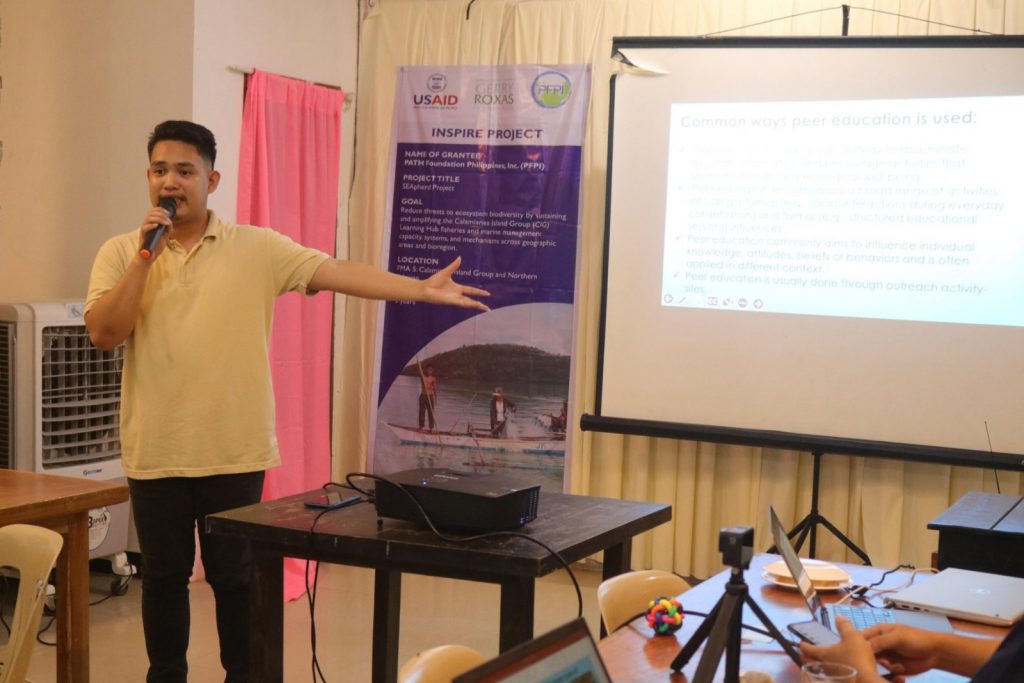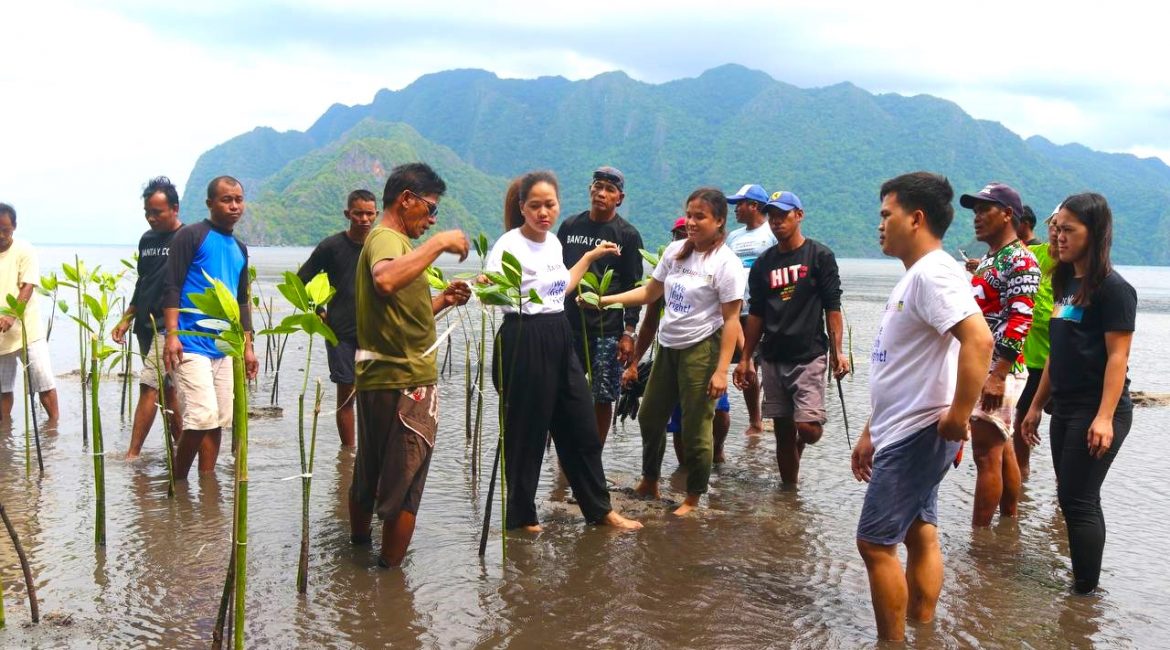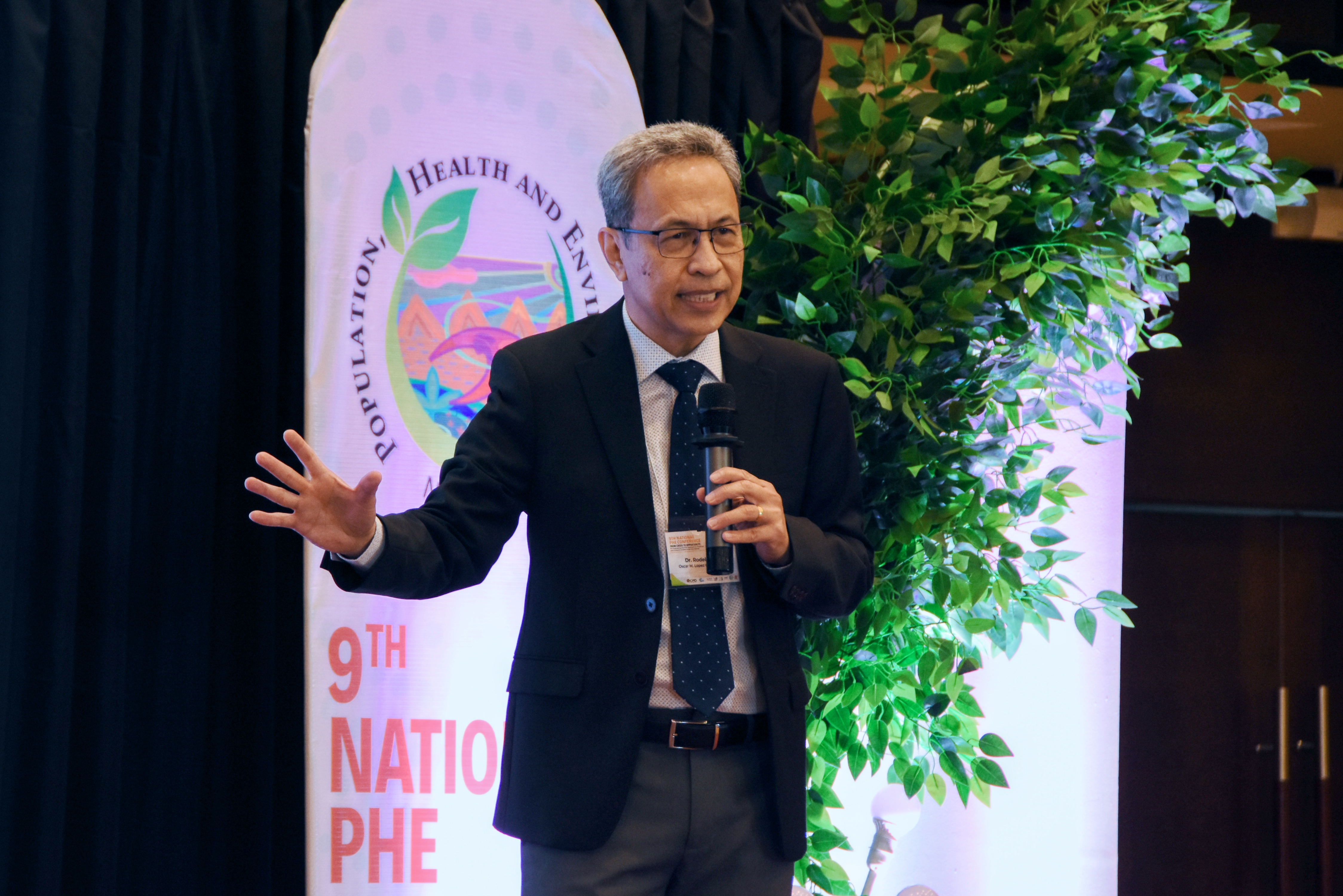Peer educator Ma. Stephanie Bajen leads a discussion on mangrove monitoring during a hands-on training in Coron, Palawan.
Many of us are familiar with peer education in family planning and reproductive health (FP/RH) advocacy. But peer education is also employed in other sectors, including environmental conservation. For three decades, PATH Foundation Philippines, Inc. (PFPI) has trained and engaged peer educators in health and conservation projects in urban and rural communities all over the country.
Peer education is a community-based approach where individuals from similar age groups or social backgrounds educate, influence and empower each other for a certain cause. Whether it be in FP/RH, HIV/AIDS prevention, water sanitation, marine conservation or other thematic areas, peer education leverages the trust and relatability peers have with one another, making it an effective tool for sharing knowledge and promoting behavioral change. In marine conservation, peer education plays a pivotal role in raising awareness, fostering sustainable practices, and galvanizing community-led initiatives for the responsible use of marine resources.
Recently, PFPI through the SEApherd Project, organized a summit titled Arampangan y ang Peer Educators: Puso para sa Karagatan (A Convergence of Conservation Champions: I Love the Ocean) on May 29–30, 2024, at the A and A Plaza Hotel in Puerto Princesa City, Palawan. Arampangan is a Cuyonon word that means conversation. The event was conducted with support from USAID Philippines through the Gerry Roxas Foundation INSPIRE Project and in partnership with the Community Centered Conservation (C3) Philippines, Culion Foundation, Inc. (CFI) and Palawan local government units. BUILD Project staff were also invited as resource persons for PHE and communications.
Since its inception in 2022, the SEApherd Project, funded through the USAID INSPIRE Project, has trained 133 community eco-warriors and peer educators across key marine biodiversity areas in Northern Palawan and the Calamianes Island Group (CIG) bioregions. These trained individuals, including women, indigenous peoples, fisherfolk, youth and local government officials, have emerged as local “Conservation Champions.”
The summit aimed to solidify the constituency and role of peer educators in promoting marine conservation. The summit gathered about 100 participants, including peer educators, government representatives, and project partners. The event featured sessions on gender, leadership, alliance-building, community mobilization, advocacy, and interactive discussions on communication, PHE and plastic pollution, among others. A notable highlight of the summit was the “Stop IUU Fishing” human formation, a first in the country, underscoring the necessity of multi-stakeholder cooperation in combating illegal, unreported, and unregulated (IUU) fishing and in conserving marine resources.
Harnessing the PE Potential
During the Arampangan summit, the remarkable potential of peer educators to advance marine conservation was emphasized. Despite their diverse sectors, age groups, and localities, these peer educators share a common denominator—a deep love for the ocean. And alongside their passion for what they do, they bring a wealth of knowledge, skills, and talents that can be leveraged not only for marine conservation but for broader environmental, health and community initiatives. Specifically, peer educators can contribute to engaging diverse stakeholders, promoting gender equity, enhancing multi-sectoral collaboration and developing cross-sector ambassadors.
Engaging Diverse Stakeholders
Peer educators have the unique potential to bridge various stakeholders, enabling more comprehensive approaches to marine conservation. By expanding their advocacy beyond traditional conservation circles to include sectors and issues such as health, food security, climate change and resilience, and economic empowerment, peer educators can capture and address interconnected development challenges impacting marine biodiversity and the wider environment. For example, linking marine conservation with public health concerns can highlight the importance of clean and healthy oceans for human well-being, while linking conservation with food security can emphasize the importance of promoting sustainable fishing practices.
Promoting Gender Equity
Mainstreaming gender equity in conservation efforts is crucial to distributing initiative, ownership and benefits for women and men. When women and girls are empowered and given decision-making roles, they can significantly contribute to actual conservation practices as well as advocacy. Gender-inclusive approaches not only enhance women’s economic and political empowerment but also ensure that conservation strategies benefit from diverse perspectives and skills. Peer educators can champion these co-benefits by championing the involvement of women and youth in all aspects of marine conservation.
Enhancing Multi-Sectoral Collaboration
The Arampangan summit demonstrated the strength of harnessing multi-sectoral collaboration. Participants from various age groups, genders, and work backgrounds showed how diverse perspectives could enrich marine conservation perspectives and efforts. By continuing to foster inter-, cross-, and multi-sectoral partnerships, peer educators can become active instruments in solidifying and amplifying collaborative conservation initiatives across Palawan and beyond, making these efforts more comprehensive and sustainable.
Developing Cross-Sector Ambassadors
Peer educators can act as cross-sector ambassadors, rallying larger commitment and support for marine conservation by tapping into other sectors. They can draw a broader constituency to the cause by communicating how marine conservation is linked to social, political, cultural, economic, and ecological challenges, and vice versa. Peer educators, for example, can help encourage environmental stewardship among young people by linking marine conservation to access to livelihoods and education; meanwhile, connecting it to urbanization and migration can help FP/RH advocates understand the importance of what they do to population trends and the health of coastal and marine ecosystems.
Scaling Up Citizen-Led Marine Conservation
The conference emphasized the potential role of peer educators in promoting marine conservation, in which ordinary citizens can participate and lead. In collaboration with government agencies and units, the prospects for success are high, with peer educators at the forefront. By combining effective advocacy strategies with practical actions, peer educators can significantly scale up citizen-led marine conservation, extending their reach to more key biodiversity areas and bioregions in the Philippines.
Advocacy Strategies
To scale up citizen-led marine conservation, it will be useful for peer educators to employ various advocacy strategies, such as:
- Community Engagement: Continue to involve local communities through forums and IEC campaigns. Customize messages to reflect local conservation issues and link these to other development challenges to improve relatability.
- Participatory Storytelling: Use storytelling to give a human face to conservation issues. Document and share personal stories with community members, as these can serve as powerful materials to illustrate current realities and benefits of conservation action.
- Harnessing the Media: Maximize traditional and social media platforms to reach and engage a wider audience. Create content relatable to multiple sectors that highlights good practices, lessons learned and impacts of conservation initiatives.
- Policy Advocacy: Peer educators can step up from influencing their peers to influencing local policies. Peer educators can work with government agencies and units to provide valuable on-the-ground insights that shape effective marine conservation policies.
Practical Actions
In addition to advocacy, peer educators can catalyze behavior and policy change. Peer educators can initiate concrete actions to further engage other stakeholders, including:
- Conservation Training: Conduct training or mentoring sessions on sustainable fishing practices, pollution control, and other topics related to marine conservation. Non-conservation but relevant topics such as gender and health can be integrated to emphasize that conservation is not a siloed concern.
- Monitoring and Reporting: Establish community-based monitoring systems to track, report and document changes in the environment as well as illegal activities. Sharing information to authorities can inform policy implementation and adjustments.
- Partnership Building: Establish partnerships with civil society organizations, academic institutions, and the business sector. Convergence projects can offer additional human and financial resource availability needed for scaling up.
- Innovation and Technology: Harness the power of digital technology to enhance conservation efforts. Many peer educators are young people who are adept at IT, e.g., in app development, and they can be mobilized to help in digitizing some aspects of conservation action.

Peer educator Rey Mark Jelo Badajos discusses how peer education works during a training for cadre of peer educators training in El Nido, Palawan.
Arampangan and Beyond
The gathering illustrated the critical role of peer educators working and expanding together in marine conservation. Peer educators can substantially boost citizen-led conservation efforts by involving various sectors, promoting gender equity, and improving cross-sector collaboration. These conservation champions can bring about substantial change by influencing individual behaviors, pursuing strategic advocacy and practical actions that can help conserve and make marine ecosystems more resilient.
Scaling up citizen-led marine conservation calls for a concerted effort from all stakeholders. Peer educators are at the forefront of this movement, bridging the gap between and among individuals, communities and policymakers and instilling a culture of collaborative conversation and stewardship. As peer educators continue to lead by example and motivate others to act, the vision of healthy marine ecosystems supporting healthy human communities (and vice versa) becomes closer to reality.





